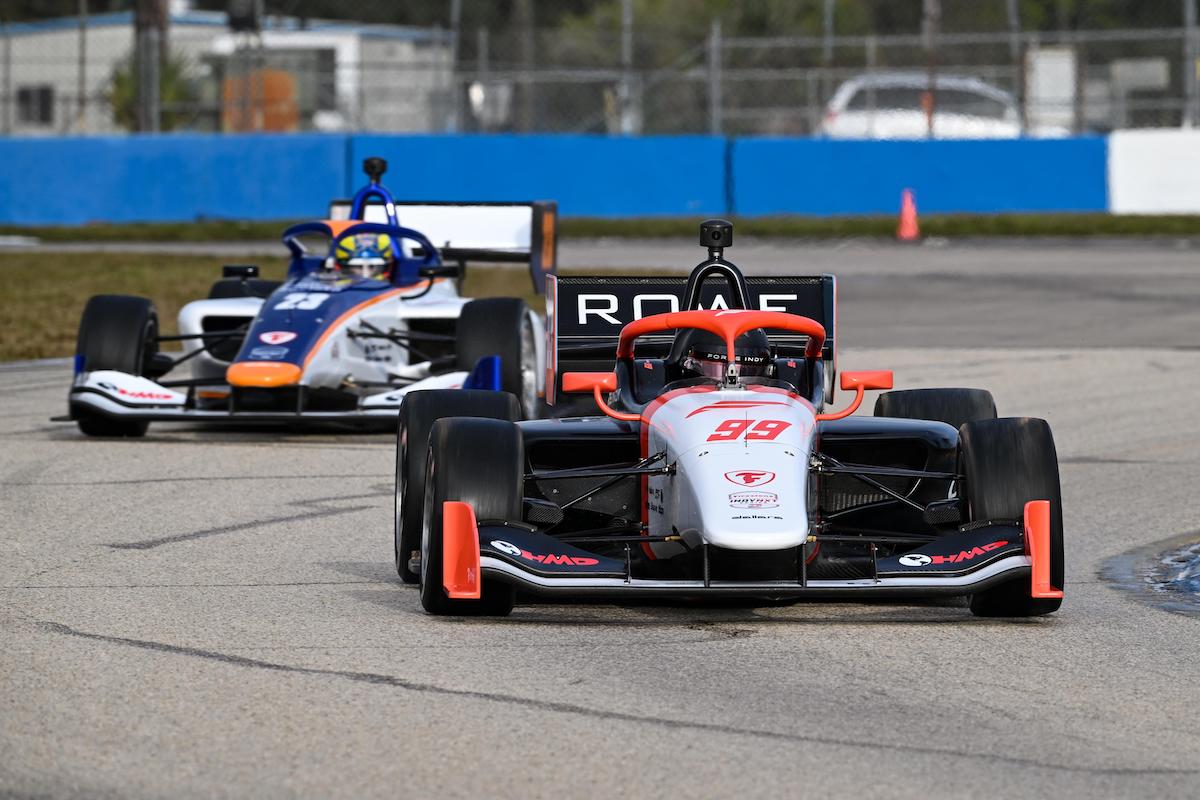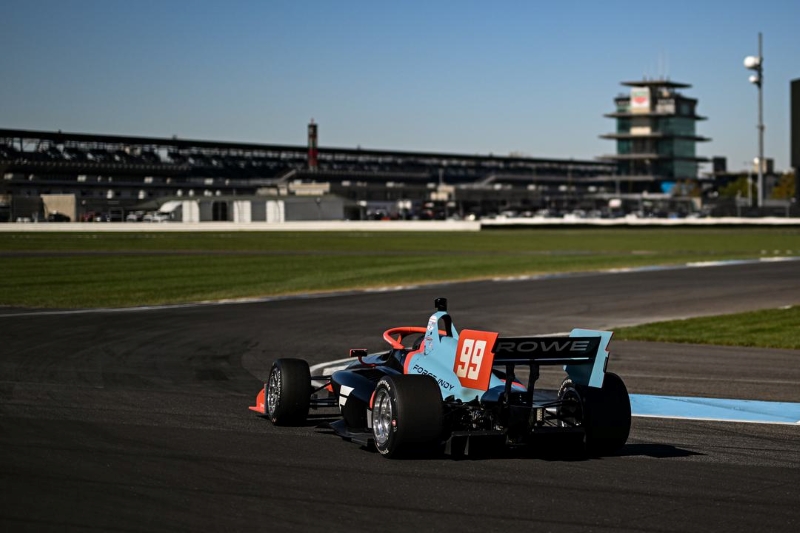
Photo: Matt Fraver
Myles Rowe is one of the most refreshing personalities in single-seaters, with an artistic vision that complements his approach to racing and an up-and-down career that could lead him to IndyCar
There’s a ‘winning means everything’ mentality that permeates through junior single-seaters. For some it’s the only way they can finance their place on the grid, for others it’s a rigid mindset picked up at a young age since the majority around them claimed that was their approach.
So many young drivers now say that to maximise their abilities they need to be ‘100% racing’, which is a counterintuitive approach to personal development in the car, let alone out of it. Having a public image so they can build a fanbase from the start of their teenaged years is now another ‘must’ due to the doors it can open to sponsorship in later years, but is a task that can be offloaded to family or even external management for the wealthier wannabe racers. It’s all work and no play.
For example, physical training (a genuine passion for some when done as a social activity or on a bicycle) is now the answer to the question ‘what do you like to do away from the track?’ rather than just a necessity to make the required fitness levels.
The lower you go down the ladder, the more homogenised it can be. That makes sense since the racers are of more impressionable ages, the budgets behind driver and team PR is limited, and ‘being you’ is very much a big learning curve where major inspirations set the template rather than an identity that is identifiably individual. Talent scouts and fans start closely following the careers of young drivers not because they exhibit unknown traits, but for impressing in familiar ways.
The Indy Nxt paddock, where drivers fight on track for the last time before becoming professionals in IndyCar, is a great location to explore the value of personality. IndyCar’s new domestic broadcasting deal with commercial television station Fox this year has led to Indy Nxt becoming more accessible to watch not only in the USA but across the world.
The marketing surrounding this deal has been about promoting IndyCar’s biggest names as characters, authentic or otherwise, and Fox and IndyCar want new drivers who are interesting outside of the car as well as in it.

Photo: James Black
Indy Nxt’s 2025 grid includes an aspiring dentist, a well-known NASCAR racer and an avid photographer who sums up his life as “creating brushstrokes of speed”. That’s an accurate self-description for Myles Rowe, who in a paddock featuring several genuinely engaging and charismatic drivers this year stands out with a laid-back approach that has a story behind it.
“My expectations really are… I think we’re just focused on consistency, clear communication,” says Rowe, looking to the season ahead with Abel Motorsports.
As a rookie in 2024 driving for HMD Motorsports, he came 11th in the standings with two top-five finishes. He qualified third on debut, his best race result was fourth in Detroit, but his highest oval finish was 14th at Nashville Superspeedway and he had been seventh in the points table prior to that leg of the season.
“Some of the struggles we had last year, we’re pretty adamant about making sure those struggles don’t happen [again]. But also just taking it race by race,” he explains.
“A goal of trying to communicate clearly in this pre-season, understanding what our strengths and most importantly our weaknesses were – communicating that clearly to me – and having the proper cohesion with everyone to make sure it is like our second season.”
If there’s any pressure to make that working relationship as reliable as possible as quickly as possible, Rowe doesn’t see it as a negative.
“[Pressure] is a very positive thing. Like that’s what I need, and that’s what we’re looking forward to. And I’m sure we’re going to do great with that momentum, is what I like to call it. Pressure makes diamonds, and I’m sure we’ll shine.”
It’s a poetic line that reflects the lens which Rowe sees racing through.

Photo: Travis Hinkle
“There’s a lot more creativity in motorsport, just in the skill of driving, than I think a lot of people understand. There’s a set line, almost like there’s a set path to everything, but you have to make that path. So in the same way where you might be in a very structured photoshoot in a studio or something, there’s a way to do it but also you have to make that way happen.
“You control the light, the power, the angle, of all of that. Same thing with the line in the car, sort of. It all depends on where you are. That path, it changes with the conditions, it changes with the track. Same thing in a shoot, it changes with the person you’re shooting with, it changes with the area, the environment, the weather that day, the lighting that day.
“And you have to anticipate just as much in both, be aware just as much as in both and understand your variables just as much in both. So I take a lot of that with me.”
Rowe also takes into his racing today what he learned from being out of it entirely. After his first steps in single-seaters in 2017 and ’18 with race-winning Lucas Oil Formula Car Race Series outings, Rowe spent the next years on the sidelines. His career was revived when the African American-led Force Indy team signed him to race in USF2000 in 2021. He took a win that year, narrowly missed out on the title in 2022 then stepped up to USF Pro 2000 and became champion of that in 2023.
“Such a journey, because I was at like 1%,” Rowe reflects on how his position now contrasts to 2019 when he was not racing.
“[Motorsport] was almost out of my mind. I’d tell people at the time that – [and] most people probably know that I stopped – I couldn’t watch it, I couldn’t watch racing. I had to disconnect. It’s too depressing. But I knew, back in my head, I would get there. I never told myself it wasn’t going to happen, I just completely took it out of my heart. Better health for myself so I could focus on college and things like that. I always knew. I always said I would [make it here], let’s say that. It’s crazy.”
He adds that time out, and being further away from his goals, “makes you more grateful” for the milestones then reached.

Photo: IndyCar
“Definitely more grateful for this journey than I think I would have been if I just kept on the same path and didn’t really have a year out of it. Makes you more aware of your tenancies, yourself, kind of how you operate. I got two sides of life, almost. Going to college and just disconnecting from ‘i want to watch a race this weekend’ to going to certain films and photoshoots and things like that, and kind of switching the whole script.
“And that path that led me here but I’m still on, because it’s still guides my life today, is something that makes me very grateful. And I’m grateful that I am the person I am because of that.”
The insight and refreshing perspectives from Rowe keeps on coming, saying he lives in the present as “it’s nice to be aware of what’s coming, but that’s not going to help me drive and win this championship”.
“All I do is focus on right now. [That applies to] everything I do in motorsport, and creatively, and the rest will come. I’m aware of it, aware of the conditions, but it changes nothing in what I do currently.”
As for what Rowe is currently doing, and has worked on in pre-season testing, there’s another interesting answer.
“I want to go specific, but I want to keep it broad enough. My mind’s going to specific things,” Rowe muses.
“A general way to talk about it is just my sensitivity to speed in general. Meaning when I go through a corner, the growth in understanding exactly not the numeric value of the miles per hour, but the sense of what each individual mph was. And to break that down the point where now I like to look at my data in kilometres, because it’s about getting even more sensitive to each individual change in that value in the change of momentum [and] movement.
“I think that’s the biggest growth I’ve had, and it will keep going. And I’m sure the Formula 1 and IndyCar drivers, they’re very sensitive to that. So that’s something, especially in the Indy Nxt series, I’ve been hyperaware of recently.

Photo: Joe Skibinski
“As you have to understand [it] – not be able to control it, but it starts with the awareness of it. And you don’t really realise it that early in your career. At least I didn’t, going through USF2000, USFP2000. I never thought maybe kilometres is a better way to think of it, but it is because it’s even a smaller thing. And that gives you the ability to control that more on entry, mid-corner, exit, and place it better.”
He concludes: “And [one day] it hit me – that’s what European drivers are doing. And it’s more fine-tuned.”